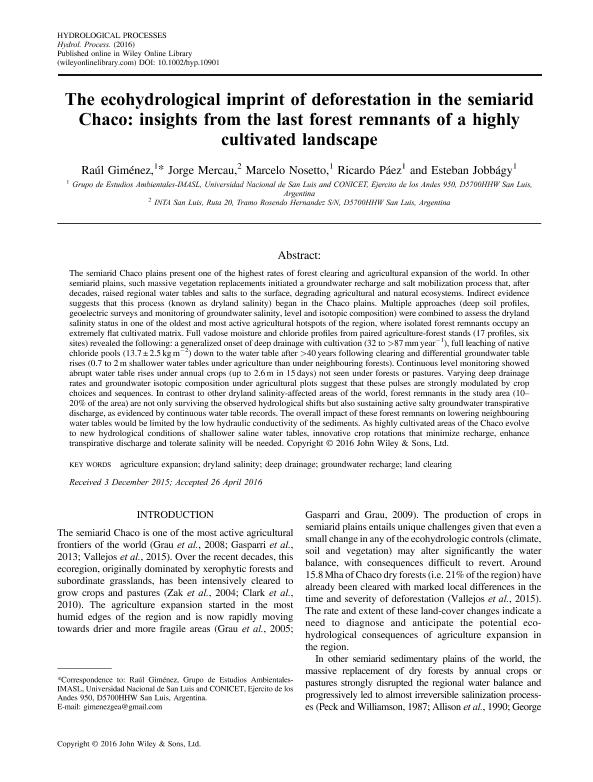Mostrar el registro sencillo del ítem
dc.contributor.author
Giménez, Raúl

dc.contributor.author
Mercau, Jorge Luis

dc.contributor.author
Nosetto, Marcelo Daniel

dc.contributor.author
Paez, Ricardo Andrés

dc.contributor.author
Jobbagy Gampel, Esteban Gabriel

dc.date.available
2018-09-20T18:14:44Z
dc.date.issued
2016-07
dc.identifier.citation
Giménez, Raúl; Mercau, Jorge Luis; Nosetto, Marcelo Daniel; Paez, Ricardo Andrés; Jobbagy Gampel, Esteban Gabriel; The ecohydrological imprint of deforestation in the semiarid Chaco: insights from the last forest remnants of a highly cultivated landscape; John Wiley & Sons Ltd; Hydrological Processes; 30; 15; 7-2016; 2603-2616
dc.identifier.issn
0885-6087
dc.identifier.uri
http://hdl.handle.net/11336/60495
dc.description.abstract
The semiarid Chaco plains present one of the highest rates of forest clearing and agricultural expansion of the world. In other semiarid plains, such massive vegetation replacements initiated a groundwater recharge and salt mobilization process that, after decades, raised regional water tables and salts to the surface, degrading agricultural and natural ecosystems. Indirect evidence suggests that this process (known as dryland salinity) began in the Chaco plains. Multiple approaches (deep soil profiles, geoelectric surveys and monitoring of groundwater salinity, level and isotopic composition) were combined to assess the dryland salinity status in one of the oldest and most active agricultural hotspots of the region, where isolated forest remnants occupy an extremely flat cultivated matrix. Full vadose moisture and chloride profiles from paired agriculture-forest stands (17 profiles, six sites) revealed the following: a generalized onset of deep drainage with cultivation (32 to >87 mm year−1), full leaching of native chloride pools (13.7 ± 2.5 kg m−2) down to the water table after >40 years following clearing and differential groundwater table rises (0.7 to 2 m shallower water tables under agriculture than under neighbouring forests). Continuous level monitoring showed abrupt water table rises under annual crops (up to 2.6 m in 15 days) not seen under forests or pastures. Varying deep drainage rates and groundwater isotopic composition under agricultural plots suggest that these pulses are strongly modulated by crop choices and sequences. In contrast to other dryland salinity-affected areas of the world, forest remnants in the study area (10–20% of the area) are not only surviving the observed hydrological shifts but also sustaining active salty groundwater transpirative discharge, as evidenced by continuous water table records. The overall impact of these forest remnants on lowering neighbouring water tables would be limited by the low hydraulic conductivity of the sediments. As highly cultivated areas of the Chaco evolve to new hydrological conditions of shallower saline water tables, innovative crop rotations that minimize recharge, enhance transpirative discharge and tolerate salinity will be needed.
dc.format
application/pdf
dc.language.iso
eng
dc.publisher
John Wiley & Sons Ltd

dc.rights
info:eu-repo/semantics/openAccess
dc.rights.uri
https://creativecommons.org/licenses/by-nc-sa/2.5/ar/
dc.subject
Agriculture Expansion
dc.subject
Deep Drainage
dc.subject
Dryland Salinity
dc.subject
Groundwater Recharge
dc.subject
Land Clearing
dc.subject.classification
Oceanografía, Hidrología, Recursos Hídricos

dc.subject.classification
Ciencias de la Tierra y relacionadas con el Medio Ambiente

dc.subject.classification
CIENCIAS NATURALES Y EXACTAS

dc.title
The ecohydrological imprint of deforestation in the semiarid Chaco: insights from the last forest remnants of a highly cultivated landscape
dc.type
info:eu-repo/semantics/article
dc.type
info:ar-repo/semantics/artículo
dc.type
info:eu-repo/semantics/publishedVersion
dc.date.updated
2018-09-20T13:11:22Z
dc.journal.volume
30
dc.journal.number
15
dc.journal.pagination
2603-2616
dc.journal.pais
Reino Unido

dc.journal.ciudad
Londres
dc.description.fil
Fil: Giménez, Raúl. Consejo Nacional de Investigaciones Científicas y Técnicas. Centro Científico Tecnológico Conicet - San Luis. Instituto de Matemática Aplicada de San Luis ; Argentina
dc.description.fil
Fil: Mercau, Jorge Luis. Instituto Nacional de Tecnología Agropecuaria; Argentina
dc.description.fil
Fil: Nosetto, Marcelo Daniel. Consejo Nacional de Investigaciones Científicas y Técnicas. Centro Científico Tecnológico Conicet - San Luis. Instituto de Matemática Aplicada de San Luis ; Argentina
dc.description.fil
Fil: Paez, Ricardo Andrés. Consejo Nacional de Investigaciones Científicas y Técnicas. Centro Científico Tecnológico Conicet - San Luis. Instituto de Matemática Aplicada de San Luis ; Argentina
dc.description.fil
Fil: Jobbagy Gampel, Esteban Gabriel. Consejo Nacional de Investigaciones Científicas y Técnicas. Centro Científico Tecnológico Conicet - San Luis. Instituto de Matemática Aplicada de San Luis ; Argentina
dc.journal.title
Hydrological Processes

dc.relation.alternativeid
info:eu-repo/semantics/altIdentifier/doi/http://dx.doi.org/10.1002/hyp.10901
dc.relation.alternativeid
info:eu-repo/semantics/altIdentifier/url/https://onlinelibrary.wiley.com/doi/abs/10.1002/hyp.10901
Archivos asociados
